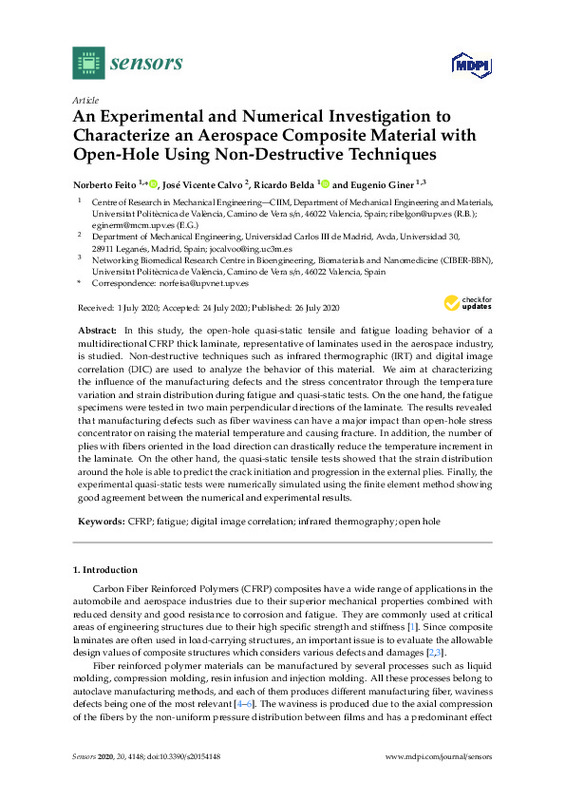JavaScript is disabled for your browser. Some features of this site may not work without it.
Buscar en RiuNet
Listar
Mi cuenta
Estadísticas
Ayuda RiuNet
Admin. UPV
An Experimental and Numerical Investigation to Characterize an Aerospace Composite Material with Open-Hole Using Non-Destructive Techniques
Mostrar el registro sencillo del ítem
Ficheros en el ítem
| dc.contributor.author | Feito-Sánchez, Norberto
|
es_ES |
| dc.contributor.author | Calvo, José Vicente
|
es_ES |
| dc.contributor.author | Belda, R.
|
es_ES |
| dc.contributor.author | Giner Maravilla, Eugenio
|
es_ES |
| dc.date.accessioned | 2021-11-05T14:08:39Z | |
| dc.date.available | 2021-11-05T14:08:39Z | |
| dc.date.issued | 2020-08 | es_ES |
| dc.identifier.uri | http://hdl.handle.net/10251/176339 | |
| dc.description.abstract | [EN] In this study, the open-hole quasi-static tensile and fatigue loading behavior of a multidirectional CFRP thick laminate, representative of laminates used in the aerospace industry, is studied. Non-destructive techniques such as infrared thermographic (IRT) and digital image correlation (DIC) are used to analyze the behavior of this material. We aim at characterizing the influence of the manufacturing defects and the stress concentrator through the temperature variation and strain distribution during fatigue and quasi-static tests. On the one hand, the fatigue specimens were tested in two main perpendicular directions of the laminate. The results revealed that manufacturing defects such as fiber waviness can have a major impact than open-hole stress concentrator on raising the material temperature and causing fracture. In addition, the number of plies with fibers oriented in the load direction can drastically reduce the temperature increment in the laminate. On the other hand, the quasi-static tensile tests showed that the strain distribution around the hole is able to predict the crack initiation and progression in the external plies. Finally, the experimental quasi-static tests were numerically simulated using the finite element method showing good agreement between the numerical and experimental results. | es_ES |
| dc.description.sponsorship | This research was funded by the FEDER programme and the Spanish Ministerio de Ciencia, Innovacion y Universidades, projects DPI2017-89197-C2-1-R and DPI2017-89197-C2-2-R. The funding of the Generalitat Valenciana, Programme PROMETEO 2016/007 is also acknowledged. | es_ES |
| dc.language | Inglés | es_ES |
| dc.publisher | MDPI AG | es_ES |
| dc.relation.ispartof | Sensors | es_ES |
| dc.rights | Reconocimiento (by) | es_ES |
| dc.subject | CFRP | es_ES |
| dc.subject | Fatigue | es_ES |
| dc.subject | Digital image correlation | es_ES |
| dc.subject | Infrared thermography | es_ES |
| dc.subject | Open hole | es_ES |
| dc.subject.classification | INGENIERIA DE LOS PROCESOS DE FABRICACION | es_ES |
| dc.subject.classification | INGENIERIA MECANICA | es_ES |
| dc.title | An Experimental and Numerical Investigation to Characterize an Aerospace Composite Material with Open-Hole Using Non-Destructive Techniques | es_ES |
| dc.type | Artículo | es_ES |
| dc.identifier.doi | 10.3390/s20154148 | es_ES |
| dc.relation.projectID | info:eu-repo/grantAgreement/AEI//DPI2017-89197-C2-1-R//TALADRADO DE COMPONENTES HIBRIDOS CFRPS/TI Y TOLERANCIA AL DAÑO DEBIDO A MECANIZADO DURANTE EL COMPORTAMIENTO EN SERVICIO DE UNIONES ESTRUCTURALES AERONAUTICAS/ | es_ES |
| dc.relation.projectID | info:eu-repo/grantAgreement/GVA//PROMETEO%2F2016%2F007//Modelado numérico avanzado en ingeniería mecánica/ | es_ES |
| dc.relation.projectID | info:eu-repo/grantAgreement/AEI//DPI2017-89197-C2-2-R-AR//TALADRADO DE COMPONENTES HIBRIDOS CFRPS/TI Y TOLERANCIA AL DAÑO DEBIDO A MECANIZADO DURANTE EL COMPORTAMIENTO EN SERVICIO DE UNIONES ESTRUCTURALES AERONAUTICAS/ | es_ES |
| dc.rights.accessRights | Abierto | es_ES |
| dc.contributor.affiliation | Universitat Politècnica de València. Departamento de Ingeniería Mecánica y de Materiales - Departament d'Enginyeria Mecànica i de Materials | es_ES |
| dc.description.bibliographicCitation | Feito-Sánchez, N.; Calvo, JV.; Belda, R.; Giner Maravilla, E. (2020). An Experimental and Numerical Investigation to Characterize an Aerospace Composite Material with Open-Hole Using Non-Destructive Techniques. Sensors. 20(15):1-18. https://doi.org/10.3390/s20154148 | es_ES |
| dc.description.accrualMethod | S | es_ES |
| dc.relation.publisherversion | https://doi.org/10.3390/s20154148 | es_ES |
| dc.description.upvformatpinicio | 1 | es_ES |
| dc.description.upvformatpfin | 18 | es_ES |
| dc.type.version | info:eu-repo/semantics/publishedVersion | es_ES |
| dc.description.volume | 20 | es_ES |
| dc.description.issue | 15 | es_ES |
| dc.identifier.eissn | 1424-8220 | es_ES |
| dc.identifier.pmid | 32722534 | es_ES |
| dc.identifier.pmcid | PMC7436093 | es_ES |
| dc.relation.pasarela | S\417813 | es_ES |
| dc.contributor.funder | Generalitat Valenciana | es_ES |
| dc.contributor.funder | AGENCIA ESTATAL DE INVESTIGACION | es_ES |
| dc.contributor.funder | Agencia Estatal de Investigación | es_ES |
| dc.contributor.funder | European Regional Development Fund | es_ES |








